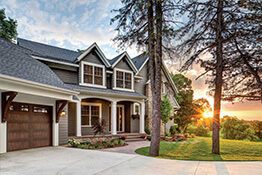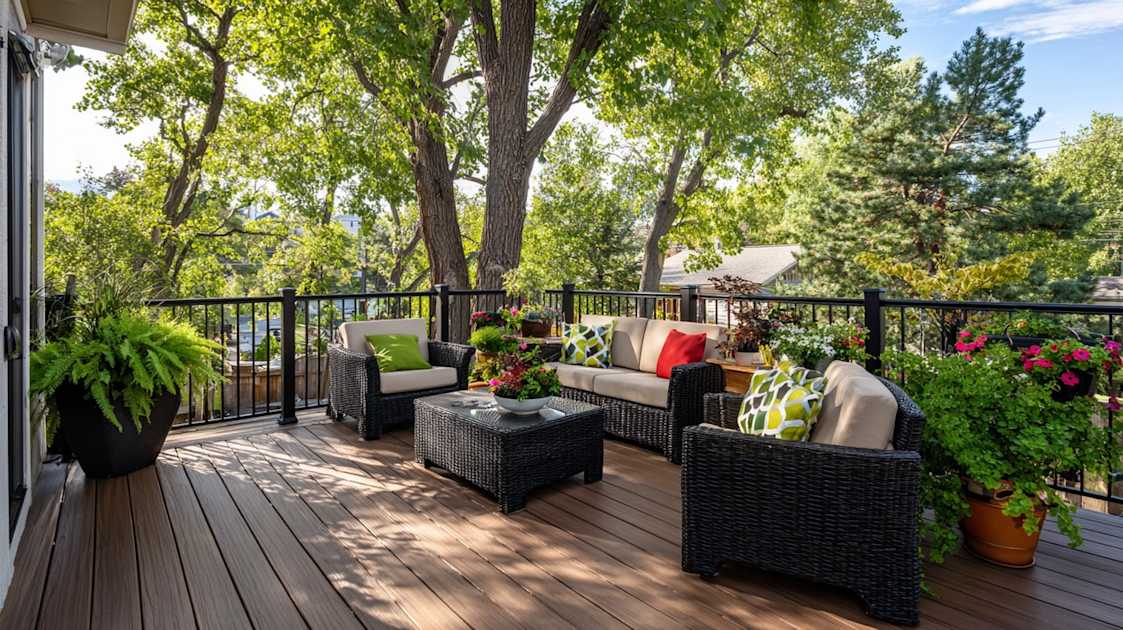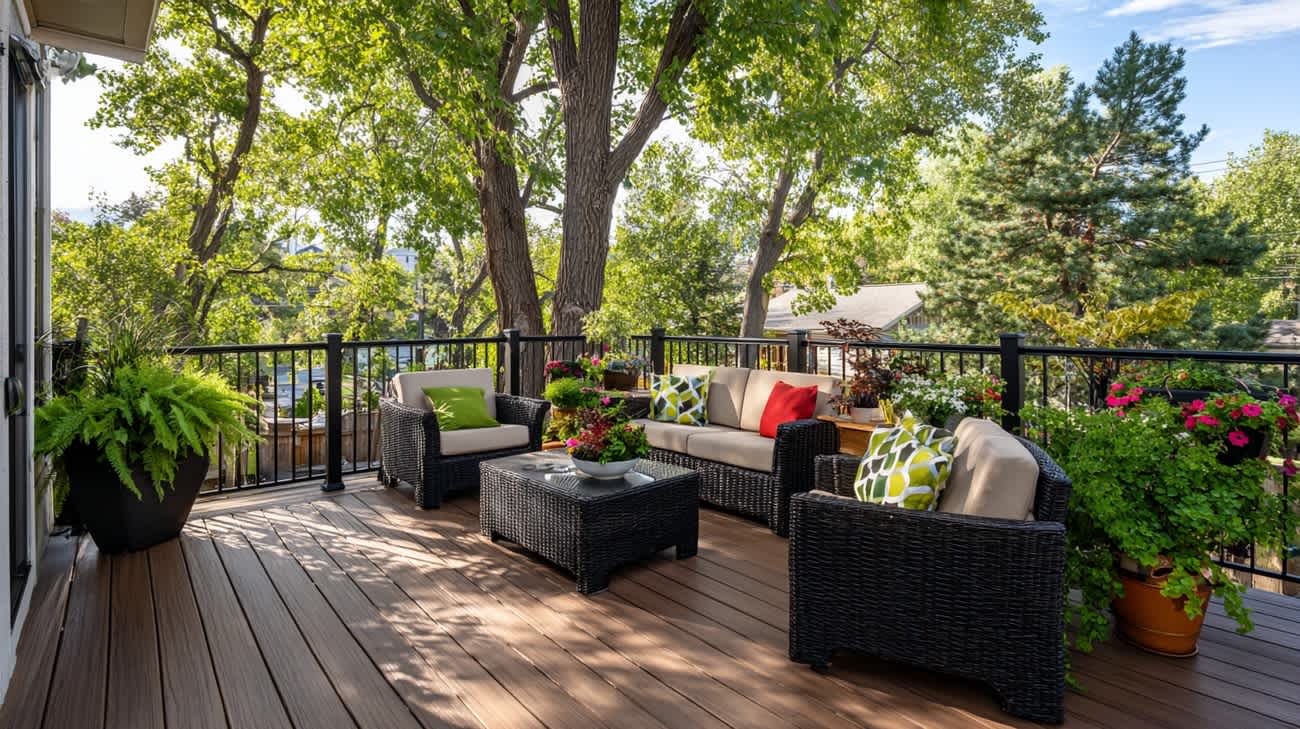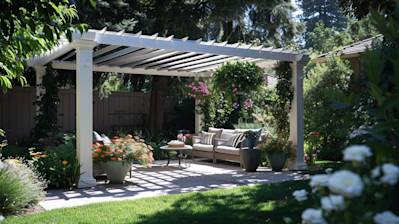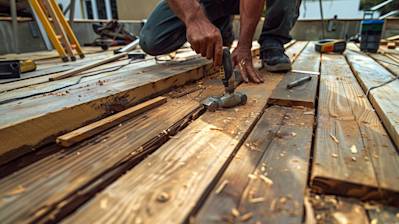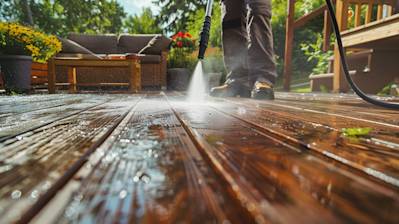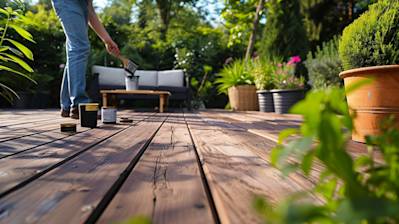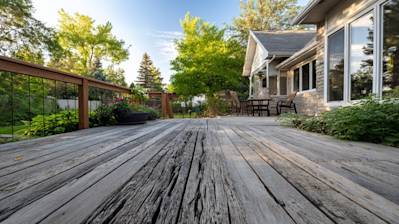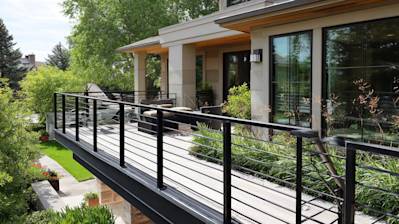Whether you're looking at building a brand new outdoor decking or upgrading an old one, your choice of decking material is extremely critical. With a myriad of options available on the market today, finding the right one could be a challenge.
From natural wood to composite materials, each comes with its unique set of features and aesthetics. As such, this article aims to help you make the right choice by thoroughly discussing the best decking material options.
Natural Wood Decking Materials
Natural wood has always been a favorite choice among homeowners due to its eye-catching beauty and timeless appeal. Here, we delve into some of the popular types.
Cedar Wood
Natural, durable, and resistant to insects and rot, cedar wood holds its position as one of the top contenders.
- Longevity: Known for its long-lasting properties, cedar can last up to 15-20 years.
- Maintenance: Requires staining and sealing every one to three years for best results and to prolong its lifespan.
Redwood
A step above the rest, redwood decking not only holds a beautiful appeal but is also highly resilient.
- Aesthetic Appeal: Redwood's rich hue adds elegance to your outdoor space.
- Resistant: It’s naturally resistant to both insects and rot.
Pressure-Treated Wood
Pressure-treated wood is a commonly used decking material due to its cost-effectiveness and longevity.
- Affordability: Pressure-treated wood makes for an affordable decking option.
- Endurance: Its chemical treatment makes it resistant to moisture, rot, and insects.
Tropical Hardwoods: Exotic and Durable
Tropical hardwoods are an excellent pick if you're looking for a blend of exotic aesthetic appeal and high durability. Some popular choices include Ipe, Camaru and Tigerwood.
Ipe
Also known as Brazilian Walnut, Ipe is a hardwood from South America and is famous for its longevity and hardness.
- Low Maintenance: Ipe requires minimal maintenance as it’s naturally resistant to water and insects.
- Aesthetic Appeal: Ipe’s deep brown color and dense grain offer a stunning visual appeal.
Tigerwood
This South American tropical hardwood known for its splendid streaks is another good pick.
- Durability: Tigerwood is remarkably durable and resistant to decay.
- Color Variety: Its light golden to reddish-brown color with dark vein stripes offers a diverse color palette.
Composite Decking
Composite decking is a modern addition to the family of decking materials. It's made from a blend of wood fibers and plastic.
Trex Composite Decking
Trex Composite Decking, the pioneer in this area, offers a wide variety of color choices and designs.
- Durability: Trex composite decks are highly resistant to scratches, stains, bugs, and even UV rays.
- Recycled Material: Trex uses 95% recycled materials, marking a shift towards a more sustainable decking option.
TimberTech Composite Decking
TimberTech is another renowned name in the composite decking industry.
- Low Maintenance: Offers the beauty of natural wood without the strenuous maintenance routine, requiring only occasional cleaning.
- Warranty: TimberTech offers a limited 30-year warranty, signifying its commitment to long-term durability.

Frequently Asked Questions about Best Decking Material Options
What are some common decking material options?
Among the most common options for decking materials include pressure-treated wood, cedarwood, composite decking materials, vinyl or PVC, and tropical hardwoods. Each of these options has its own unique qualities and advantages from a maintenance, durability, cost, and aesthetic perspective.
Could you elaborate more on pressure-treated wood as a decking material?
Pressure-treated wood is often used as a decking material due to its reasonable cost and wide availability. It is treated with chemicals to resist rot, decay, and termite damage, making it more durable than untreated wood. Although it requires annual maintenance to prolong its lifespan, it remains a compelling choice for homeowners looking for an optimum balance between cost and performance.
What makes cedarwood a good decking material option?
Cedarwood is a popular decking material option due to its natural beauty, durability, and resistance to pests. Its enticing coloring and grain pattern make it an aesthetically pleasing choice. While it's more expensive than pressure-treated wood, it doesn't carry any pesticides, making it an eco-friendlier option. However, to maintain its vibrant color and resist decay, regular maintenance is required.
How does composite rate as a decking material option?
Composite decking material is manufactured from a combination of wood fibers and plastic. It combines the appealing aspects of wood's aesthetic appeal with the durability and low maintenance of synthetic materials. It's resistant to rotting, warping, and insect damage. Although the upfront cost is higher, it requires less periodic maintenance which may make it a cost-effective option in the long run.
Can you tell me more about vinyl or PVC as a decking material?
Vinyl or PVC (polyvinyl chloride) is solely synthetic with no wood fibers included. It offers high resistance to wear and tear and doesn't warp, rot or splinter, making it an excellent low-maintenance option. It doesn't require staining or painting and cleaning can easily be done with soap and water. Its look, however, doesn't entirely mimic the natural feel of wood, which might be a disadvantage for some.
What advantages do tropical hardwoods offer as decking materials?
Tropical hardwoods, such as ipe, teak, mahogany, and others, are highly durable and naturally resistant to rotting, warping, and insect infestation. Their dense nature makes them less prone to scratches and severe weather damage. They offer superior aesthetic appeal with rich, striking colors and complex grain patterns. However, these benefits come at a higher cost and might require special fasteners to install due to their extreme hardness.
Are there any innovative decking material options available?
Yes, aluminum is an unconventional option that is fireproof, easy to maintain, and recyclable. It does not rot or attract pests and is resistant to mold, mildew, and fading. However, the high thermal conductivity of aluminum can make it hot under the sun and potentially slippery when wet.
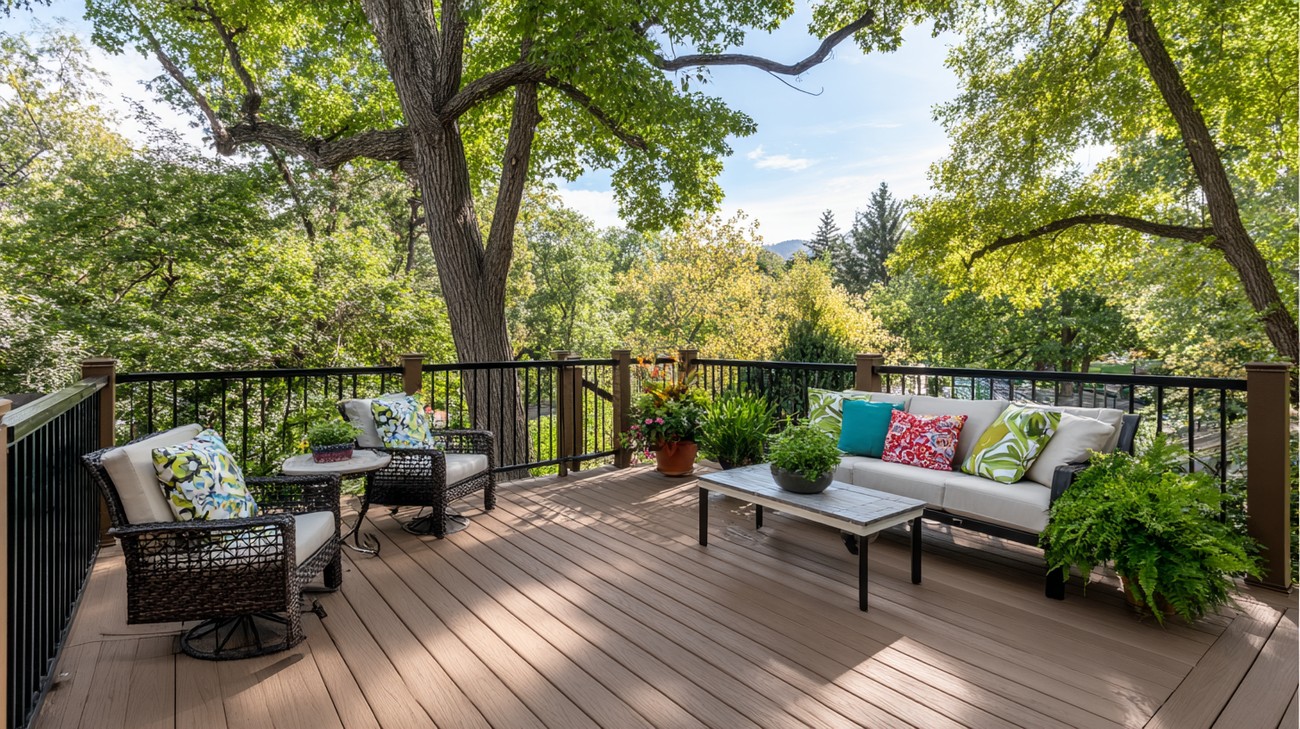
Best Decking Material Options
There are various options available for decking materials each with its pros and cons. Some of the popular decking material options include pressure-treated wood, natural wood, composite decking, and plastic decking. Below is a comprehensive overview of each decking material, including both their pros and cons.
Pressure-Treated Wood
Pros
Affordability: Pressure-treated wood is one of the most affordable options for decking materials. It's a cost-effective option especially for larger decks.
Durability: The process of pressure treating the wood makes it last longer by making it more resistant to rot, decay, and insects.
Availability: It is readily available in most hardware and home improvement stores making it a more convenient option.
Cons
Maintenance: Pressure-treated wood requires regular maintenance including staining, sealing, and painting to prevent it from warping, cracking, or rotting.
Health Concerns: Some pressure-treated woods contain chemicals that can be harmful if inhaled during sawing or sanding.
Aesthetic Limitations: These decks may not be as visually appealing as other decking materials.
Natural Wood
Pros
Aesthetic Appeal: Natural wood decks have a timeless and classic appeal.
Variety: There are various types of natural wood to choose from including cedar, redwood, and tropical hardwoods each with different hues, grains, and textures.
Cons
High Maintenance: Natural wood decks need to be sanded, stained and sealed regularly to maintain their look and prevent decay.
Cost: While the upfront cost of natural wood can vary depending on the type, the long term costs can add up due to regular maintenance requirements.
Composite Decking
Pros
Low Maintenance: Composite decking requires less maintenance than wood. It doesn't need to be stained, sealed, or painted.
Durability: Composite decks are resistant to rot, insects, and UV rays.
Aesthetic Appeal: Composite decking can mimic the look of natural wood and is available in a variety of colors and textures.
Cons
Expensive: Composite decking can be more expensive than other types of decking materials.
Heat Retention: Composite decks tend to retain heat, which can make them uncomfortably hot to walk on during sunny days.
Limited longevity: Even though composite decking is built to last, it's not as everlasting as concrete or stone options.
Plastic Decking
Pros
Durability: Plastic decking is resistant to weather, insects, and mould, and doesn't splinter or crack because it's not made from wood fibers.
Low Maintenance: Similar to composite decking, plastic decking doesn't need to be stained, sealed, or painted.
Cons
Unnatural Appearance: Plastic decks can look less natural and less appealing than wood or composite decks.
Cost: Plastic decking can be more expensive than wood, although it may be less expensive than composite decking.
Heat Retention: Similar to composite decking, plastic decking can also retain heat making it uncomfortable to walk on during sunny days.
Overall, the best decking material comes down to personal preference and budget. Homeowners need to consider factors such as maintenance requirements, appearance, cost, lifespan and environmental impact before making a decision.

Myths and Misconceptions about Decking Material Options
There are various types of decking materials available on the market. Each type has its own unique characteristics that make it suitable for different applications. However, there exist many myths and misconceptions concerning decking materials and their respective benefits or drawbacks. The purpose of this section is to debunk these myths and offer clear, accurate information.
Myth 1: Wood is Always the Best Decking Material
Wood, specifically, cedar, redwood, and pine, is often considered the traditional and always best choice for decking. However, this is not necessarily true. Materials like composite decking, made of plastic and wood fibers, or aluminum can be long-lasting, require less maintenance, and provide an attractive appearance. Plus, wood can be prone to splintering, warping, and certain pests which can cause deterioration over time.
Fact: Best Material Depends on Individual Needs
The best decking material ultimately depends on factors such as the climate, maintenance requirements, aesthetics, budget, and personal preference.
Myth 2: Composite Decking Looks Cheap and Unnatural
Many people believe that composite decking cannot replicate the natural beauty of real wood. This is a common misconception. Modern composite decking can mimic the look of various types of wood grain, offering a wide range of colors and styles.
Fact: Modern Composite Decking has Improved Aesthetics
Modern composite materials have greatly improved in terms of aesthetics. High-quality composite decking can look just as natural and attractive as real wood, without the need for regular staining or painting.
Myth 3: All Types of Plastic Decking are the Same
There is certainly a huge variation in the quality, longevity, and aesthetic appeal of different plastic decking options. PVC (polyvinyl chloride) and composite are two types of plastic decking, but they are not the same. Both have unique properties, advantages, and drawbacks.
Fact: Plastic Decking Comes in Various Types
Different types of plastic decking materials, including PVC and composite, have different levels of durability, maintenance requirements, and environmental implications.
Myth 4: Aluminum Decking is Too Hot to Walk on in the Sun
A common belief is that aluminum decking gets too hot under foot in summer, making it uncomfortable to walk on. However, this is not exactly the truth. When exposed to the sun, all types of decking materials heat up - but some materials absorb and retain more heat than others.
Fact: Aluminum Reflects Heat
Aluminum decking is actually one of the cooler options as it reflects most of the sun's rays, keeping the surface temperature relatively low.
Myth 5: Decking Material Doesn't Affect the Environment
Many believe that the choice of decking material has little to no impact on the environment. But this couldn’t be further from the truth.
Fact: Decking Material Choice Impacts Environment
Choosing a deck material does have an environmental impact, especially cumulatively over many homes and over time. The impact of harvesting wood for decks can contribute to deforestation and habitat loss. On the other hand, some plastic and composite decks are made from recycled materials, reducing their environmental footprint.
Myth 6: Maintenance-Free Decking Exists
No decking material is truly maintenance free. All decks require some level of care to keep them looking good and to help ensure a long lifespan.
Fact: All Decking Requires Maintenance
Even low-maintenance materials like composite or PVC still need periodic cleaning to prevent mold and mildew. Wood decks need to be sealed and stained every couple of years. Regular inspection for damage and repairs are also part of owning a deck, regardless of the material used.
By understanding the facts, you can make an informed decision about the best decking material for your specific needs and preferences, ignoring common misconceptions.
Summary
So, it’s pretty clear that the best decking material options greatly depend on your needs and lifestyle. Some will love the rustic appeal and sustainability of wood, while others might favor the superior durability of composite materials. Alternatively, if pricing is your main concern, you might gravitate towards a pressure-treated option. It's all about weighing pros and cons according to your specific requirements.
Remember, when choosing among the best decking material options, you must consider not only the upfront cost but also the maintenance needs in the long run. While natural materials like wood can be cheaper initially, they may require regular sealing and staining to prevent decay. On the other hand, synthetic materials may be pricier initially, but could save you bucks and sweat over time since they require less upkeep.
While there are a multitude of decking material options available today, the ultimate choice boils down to your personal preference and circumstances. From natural to engineered materials, each comes with its own set of benefits and challenges. Therefore, understanding these can help make an informed decision on the best decking material suitable for your unique situation. After all, your deck should be a reflection of you – your taste, your lifestyle, and your willingness to maintain it in its best possible condition.
About US Quality Construction of Lexington
At US Quality Construction of Lexington, we're more than just a construction company. Based in beautiful Lexington, KY, our team of dedicated professionals has been building dreams into reality since our inception. As a group of highly skilled and experienced professionals, we excel in transforming spaces according to our customers' needs. We pour our heart and soul into every project and pay keen attention to fine details, ensuring top-tier quality. We’re proud of our Lexington roots and treat every client like a neighbor, whether it's a small home repair job or a large commercial project. We believe in the vision of our clients and see ourselves as partners in their journey to introduce functionality and artistry through quality construction.
Tags: decking materials, outdoor flooring, wood vs composite,
